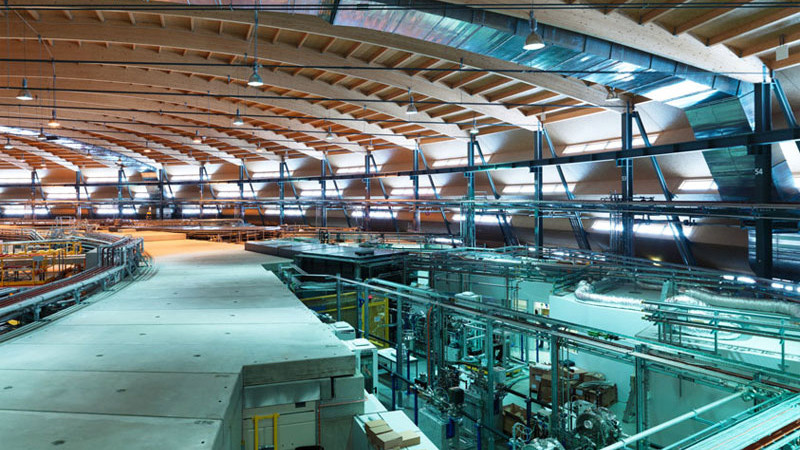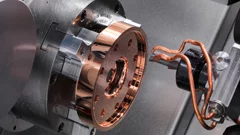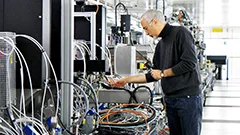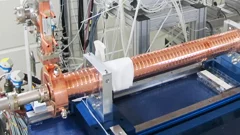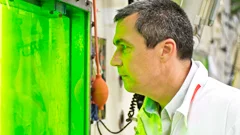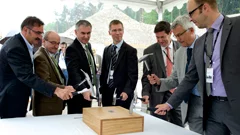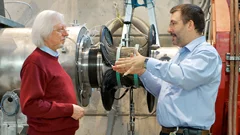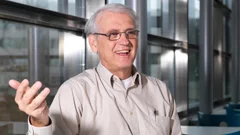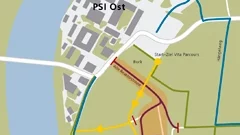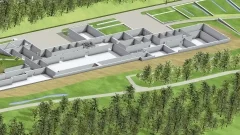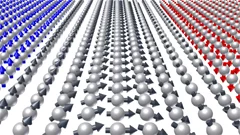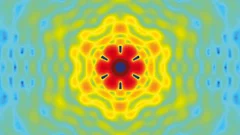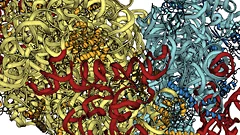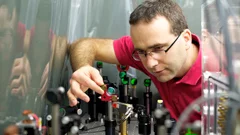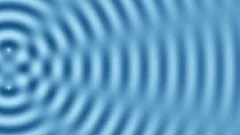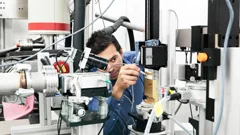Large Research Facilities
Sometimes, one needs unusually large pieces of equipment to look at the smallest of objects – because only these large machines or facilities can generate the probes
that are needed to examine matter in such a way that the information being sought can be obtained. PSI maintains a number of such facilities, making them available as a service for other institutions, but also using them for its own research. These facilities are unique within Switzerland, and PSI is the only location in the world for some of the facilities
Read more at: Large Research Facilities
Further information
The SwissFEL facility: the linear accelerator
In the linear accelerator, the electron beam receives the kinetic energy it needs in order to generate X-ray light. The linear accelerator is, in total, more than 300 metres long and at its heart there are 11,752 specially shaped copper discs in which the accelerating field is created.
The SwissFEL facility: the electron source
The electron beam for SwissFEL will be generated in an electron source. The demands of this component are very high: in order for the SwissFEL to be operated successfully, the electron beam must be of the highest quality from the very beginning.
First SwissFEL accelerator structure completed
At the PSI, the first accelerator structure has been completed for the linear accelerator of SwissFEL. A total of 104 of these structures are needed to accelerate the electrons to the required energy to produce the X-ray pulses in SwissFEL. The component manufactured using high-precision technology is currently undergoing high-performance testing.
Knowledge for tomorrow from "hot cells"
The manipulation and examination of irradiated and therefore radioactive objects, be they from nuclear power stations or research facilities, requires strict safety measures. Tests may only be conducted in so-called hot cells, where the radioactivity is hermetically enclosed and shielded behind concrete and lead walls up to 1 metre thick. In the hot cells of the PSI hot lab, the burnt-off fuel rods from the Swiss nuclear power stations are studied from a materials science perspective. The insights gained help nuclear power station operators to optimise the efficiency and safety of their plants. Besides this service, the hot lab is involved in several international research projects.
Laying of the corner stone for the new large research facility SwissFEL
At the ceremony on 3 July 2013, not only did the PSI lay the corner stone for the new large research facility SwissFEL, but it also paved the way for the continuation of twenty-five years of successful research at the institute.
Experiments in millionths of a second
Muons à unstable elementary particles à provide scientists with important insights into the structure of matter. They provide information about processes in modern materials, about the properties of elementary particles and the nature of our physical world. Many muon experiments are only possible at the Paul Scherrer Institute because of the unique intense muon beams available here.
The idea-collector
The X-ray laser SwissFEL will provide researchers with novel experimental opportunities for gaining insights into a large variety of materials and processes. But, how do we identify which scientists will benefit most from the facility and in what way the facility should be configured to best meet their needs? Bruce Patterson, the SwissFEL’s idea-collector, explains how this search is done.
Alternativ-Routen für Velofahrer und Fussgänger
Durch die Bauarbeiten für den SwissFEL kommt es im Würenlinger Wald zu Sperrungen und Umleitungen. Alternativ-Routen für Velofahrer und Fussgänger werden angeboten.This news release is only available in German.
Beginning of construction in the Würenlingen forest
Construction work for SwissFEL has now started in the Würenlingen forest, and the building for this new Large Research Facility for the Paul Scherrer Institute PSI will be erected during the next year and a half.
Research at SwissFEL: Looking into magnetic materials
Materials with special magnetic properties play an important role in modern technologies à for example, in the hard disc drives used to store data on a computer. Research at SwissFEL will help us to develop new magnetic materials, and to observe the fast processes in these materials as they happen. Thus, we will be able to see exactly what happens inside a hard disc when its data content is modified.
X-ray Laser: A novel tool for structural studies of nano-particles
Prominent among the planned applications of X-ray free electron laser facilities, such as the future SwissFEL at the Paul Scherrer Institute, PSI, are structural studies of complex nano-particles, down to the scale of individual bio-molecules. A major challenge for such investigations is the mathematical reconstruction of the particle form from the measured scattering data. Researchers at PSI have now demonstrated an optimized mathematical procedure for treating such data, which yields a dramatically improved single-particle structural resolution. The procedure was successfully tested at the Swiss Light Source synchrotron at PSI.
A green light for SwissFEL
The completion of all required approvals gives a green light for the construction of SwissFEL, the new large research facility at the Paul Scherrer Institute PSI.
Building rights agreement signed
A new Large Research Facility, SwissFEL, is to be built in the Würenlingen forest, very close to the Paul Scherrer Institute (PSI). On Friday, February 22, 2013, the building permit was signed with the Citizens’ Commune of Würenlingen.
Research at SwissFEL: Seeing through the building blocks of life
Experiments at SwissFEL will help us understand important processes in living organisms. They will reveal how vital biomolecules, whose structures cannot be determined using current techniques à are constructed. They will also reveal how the shapes of these molecules change. This knowledge will help us understand disease processes and to develop the drugs needed to treat them.
SwissFEL – The facility
Inside the SwissFEL, electrons will be accelerated to almost the speed of light, then forced along a curved pathway by very powerful magnets, emitting X-ray light as they travel. SwissFEL is thus composed of an electron gun’ (which generates the electron beam), an accelerator, and an undulator in which the electrons are guided along a wave-like path. An experimental area lies at the end of this track, where the light produced will be used to perform experiments.
Proton size puzzle reinforced!
An international team of scientists confirmed the surprisingly small value of the proton radius with laser spectroscopy of exotic hydrogen. The experiments were carried out at PSI which is the only research institute in the world providing the necessary amount of muons for the production of the exotic hydrogen atoms made up of a muon and a proton.
The advantages of SwissFEL: Why X-rays?
SwissFEL will generate very short pulses of intense X-ray light with laser-like properties, and will therefore provide new insights into a wide variety of materials. The properties of this special "SwissFEL light" will broaden the scope of experiments that can be carried out at this facility.
Watching substances convert
Experiments at SwissFEL will help us understand in detail how one substance is transformed into another during a chemical reaction. Highest priority will be given to catalytic reactions, as these have numerous industrial applications. This research will point the way towards more energy-efficient industrial processes and environmentally-friendly energy carriers.
Erschliessungsarbeiten für den SwissFEL starten
Am 3. September 2012 starten die Erschliessungsarbeiten zur neuen Grossforschungsanlage SwissFEL des Paul Scherrer Instituts. Mit ihnen wird die für den SwissFEL notwendige Anbindung an die vorhandene PSI-Infrastruktur hergestellt.This news release is only available in German.
Ultra-short X-ray laser pulses precisely surveyed for the first time
X-ray lasers are modern light sources from which scientists expect to obtain new knowledge about the structure and function of materials at the atomic level. The scientific value of an X-ray laser stands or falls on the quality of the ultra-short X-ray pulses it produces and which researchers use to illuminate their samples. An international team led by scientists from the Paul Scherer Institute, PSI, has now precisely measured these pulses
